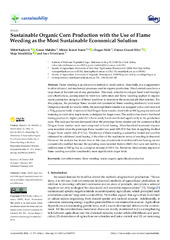Приказ основних података о документу
Sustainable Organic Corn Production with the Use of Flame Weeding as the Most Sustainable Economical Solution
| dc.creator | Rajković, Miloš | |
| dc.creator | Malidža, Goran | |
| dc.creator | Tomas Simin, Mirela | |
| dc.creator | Milić, Dragan | |
| dc.creator | Glavas-Trbić, Danica | |
| dc.creator | Meseldžija, Maja | |
| dc.creator | Vrbničanin, Sava | |
| dc.date.accessioned | 2021-04-26T19:58:31Z | |
| dc.date.available | 2021-04-26T19:58:31Z | |
| dc.date.issued | 2021 | |
| dc.identifier.issn | 2071-1050 | |
| dc.identifier.uri | http://fiver.ifvcns.rs/handle/123456789/2088 | |
| dc.description.abstract | Flame weeding is an alternative method of weed control. Essentially, it is a supplement to other physical and mechanical processes used in organic production. Weed control costs have a large share of the total cost of crop production. This study aimed to investigate hand weed hoeing's cost-effectiveness, accompanied by inter-row cultivation and flame weeding applied in organic maize production using two different machines to determine the economically best solution. For this purpose, the prototype flame weeder and commercial flame-weeding machinery were used. Designed primarily for smaller fields, the prototype flame weeder was equipped with a cultivator and a 70 kg propane bottle. Commercial Red Dragon flame weeder, fitted with an 800 kg propane tank and featuring no cultivation implements, is designed for larger areas. The analysis has shown that hand hoeing produced a higher yield (8.3 t/ha in total), but it contributed significantly to the production costs. The costs per hectare decreased when the prototype flame weeder and the commercial Red Dragon flame weeder were used compared to hand hoeing. More beneficial economic impacts were recorded when the prototype flame weeder was used (489.39 euro/ha) than in applying the Red Dragon flame weeder (456.47 euro/ha). The efficacy of flame weeding is somewhat limited and could be enhanced by additional hand hoeing, if the effect of the machine in terms of weeding is observed. However, the analysis has shown that, in this case, investments in additional hand hoeing are not economically justified because the operating costs incurred therein (168 euro/ha) were not met by a yield increase of 500 kg/ha, i.e., a surplus revenue of 100 euro/ha. Moreover, the economic impacts of flame weeding would be considerably more significant in larger fields. | en |
| dc.publisher | Basel : MDPI | |
| dc.relation | info:eu-repo/grantAgreement/MESTD/inst-2020/200032/RS// | |
| dc.relation | info:eu-repo/grantAgreement/MESTD/inst-2020/200117/RS// | |
| dc.rights | openAccess | |
| dc.rights.uri | https://creativecommons.org/licenses/by/4.0/ | |
| dc.source | Sustainability | |
| dc.subject | cost-effectiveness | en |
| dc.subject | flame weeding | en |
| dc.subject | maize | en |
| dc.subject | organic agricultural production | en |
| dc.title | Sustainable Organic Corn Production with the Use of Flame Weeding as the Most Sustainable Economical Solution | en |
| dc.type | article | |
| dc.rights.license | BY | |
| dc.citation.issue | 2 | |
| dc.citation.other | 13(2) | |
| dc.citation.rank | M22 | |
| dc.citation.volume | 13 | |
| dc.identifier.doi | 10.3390/su13020572 | |
| dc.identifier.fulltext | http://fiver.ifvcns.rs/bitstream/id/1017/2085.pdf | |
| dc.identifier.scopus | 2-s2.0-85099123472 | |
| dc.identifier.wos | 000611748500001 | |
| dc.type.version | publishedVersion |


